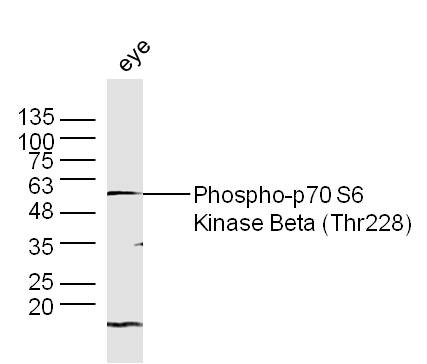
Rabbit Anti-Phospho-p70 S6 Kinase Beta (Thr228)antibody
P70 S6 Kinase beta (phospho Thr228); P70 S6 Kinase beta (phospho-T228); p-P70 S6 Kinase beta (Thr228); p-P70 S6 Kinase beta (T228); 70 kDa ribosomal protein S6 kinase 2; EC 2.7.11.1; KS6B2_HUMAN; p70 beta; p70 ribosomal S6 kinase beta; p70 S6 kinase beta;
View History [Clear]
Details
Product Name Phospho-p70 S6 Kinase Beta (Thr228) Chinese Name 磷酸化核糖体S6蛋白激酶β2抗体 Alias P70 S6 Kinase beta (phospho Thr228); P70 S6 Kinase beta (phospho-T228); p-P70 S6 Kinase beta (Thr228); p-P70 S6 Kinase beta (T228); 70 kDa ribosomal protein S6 kinase 2; EC 2.7.11.1; KS6B2_HUMAN; p70 beta; p70 ribosomal S6 kinase beta; p70 S6 kinase beta; p70 S6K-beta; p70 S6KB; p70 S6Kbeta; p70(S6K) beta; p70-beta; p70-S6K 2; P70S6K2; p70S6Kb; Ribosomal protein S6 kinase 70kDa, polypeptide 2; Ribosomal protein S6 kinase beta 2; Ribosomal protein S6 kinase beta-2; Rps6kb2; S6 kinase related kinase; S6 kinase-related kinase; S6K beta 2; S6K beta; S6K-beta; S6K-beta-2; S6K2; Serine/threonine protein kinase 14 beta; Serine/threonine-protein kinase 14B; SRK; STK14B. Product Type Phosphorylated anti Research Area Tumour immunology Signal transduction Apoptosis transcriptional regulatory factor Kinases and Phosphatases Immunogen Species Rabbit Clonality Polyclonal React Species Mouse, (predicted: Human, Rat, Chicken, Dog, Pig, Cow, Horse, ) Applications WB=1:500-2000 ELISA=1:5000-10000
not yet tested in other applications.
optimal dilutions/concentrations should be determined by the end user.Theoretical molecular weight 59kDa Cellular localization The nucleus Form Liquid Concentration 1mg/ml immunogen KLH conjugated synthesised phosphopeptide derived from human RPS6KB2 around the phosphorylation site of Thr228: TH(p-T)FC Lsotype IgG Purification affinity purified by Protein A Buffer Solution 0.01M TBS(pH7.4) with 1% BSA, 0.03% Proclin300 and 50% Glycerol. Storage Shipped at 4℃. Store at -20 °C for one year. Avoid repeated freeze/thaw cycles. Attention This product as supplied is intended for research use only, not for use in human, therapeutic or diagnostic applications. PubMed PubMed Product Detail This gene encodes a member of the ribosomal S6 kinase family of serine/threonine kinases. The encoded protein responds to mTOR (mammalian target of rapamycin) signaling to promote protein synthesis, cell growth, and cell proliferation. Activity of this gene has been associated with human cancer. Alternatively spliced transcript variants have been observed. The use of alternative translation start sites results in isoforms with longer or shorter N-termini which may differ in their subcellular localizations. There are two pseudogenes for this gene on chromosome 17. [provided by RefSeq, Jan 2013].
Function:
Serine/threonine-protein kinase that acts downstream of mTOR signaling in response to growth factors and nutrients to promote cell proliferation, cell growth and cell cycle progression. Regulates protein synthesis through phosphorylation of EIF4B, RPS6 and EEF2K, and contributes to cell survival by repressing the pro-apoptotic function of BAD. Under conditions of nutrient depletion, the inactive form associates with the EIF3 translation initiation complex. Upon mitogenic stimulation, phosphorylation by the mammalian target of rapamycin complex 1 (mTORC1) leads to dissociation from the EIF3 complex and activation. The active form then phosphorylates and activates several substrates in the preinitiation complex, including the EIF2B complex and the cap-binding complex component EIF4B. Also controls translation initiation by phosphorylating a negative regulator of EIF4A, PDCD4, targeting it for ubiquitination and subsequent proteolysis. Promotes initiation of the pioneer round of protein synthesis by phosphorylating POLDIP3/SKAR. In response to IGF1, activates translation elongation by phosphorylating EEF2 kinase (EEF2K), which leads to its inhibition and thus activation of EEF2. Also plays a role in feedback regulation of mTORC2 by mTORC1 by phosphorylating RICTOR, resulting in the inhibition of mTORC2 and AKT1 signaling. Mediates cell survival by phosphorylating the pro-apoptotic protein BAD and suppressing its pro-apoptotic function. Phosphorylates mitochondrial URI1 leading to dissociation of a URI1-PPP1CC complex. The free mitochondrial PPP1CC can then dephosphorylate RPS6KB1 at 'Thr-412', which is proposed to be a negative feedback mechanism for the RPS6KB1 anti-apoptotic function. Mediates TNF-alpha-induced insulin resistance by phosphorylating IRS1 at multiple serine residues, resulting in accelerated degradation of IRS1. In cells lacking functional TSC1-2 complex, constitutively phosphorylates and inhibits GSK3B. May be involved in cytoskeletal rearrangement through binding to neurabin.
Subunit:
Interacts with PPP1R9A/neurabin-1. Interacts with RPTOR. Interacts with IRS1. Interacts with EIF3B and EIF3C. Interacts with POLDIP3 and TRAF4.
Subcellular Location:
Cell junction, synapse, synaptosome. Mitochondrion outer membrane. Mitochondrion.Note=Colocalizes with URI1 at mitochondrion. Isoform Alpha I: Nucleus. Cytoplasm. Isoform Alpha II: Cytoplasm.
Tissue Specificity:
Widely expressed.
Post-translational modifications:
Phosphorylation at Thr-412 is regulated by mTORC1. The phosphorylation at this site is maintained by an agonist-dependent autophosphorylation mechanism (By similarity). Activated by phosphorylation at Thr-252 by PDPK1. Dephosphorylation by PPP1CC at Thr-412 in mitochondrion.
Similarity:
Belongs to the protein kinase superfamily. AGC Ser/Thr protein kinase family. S6 kinase subfamily.
Contains 1 AGC-kinase C-terminal domain.
Contains 1 protein kinase domain.
SWISS:
Q9UBS0
Gene ID:
6199
Database links:Entrez Gene: 6199 Human
Entrez Gene: 58988 Mouse
Omim: 608939 Human
SwissProt: Q9UBS0 Human
SwissProt: Q9Z1M4 Mouse
Unigene: 534345 Human
Unigene: 271937 Mouse
Unigene: 162512 Rat
Product Picture
Bought notes(bought amounts latest0)
No one bought this product
User Comment(Total0User Comment Num)
- No comment



 +86 571 56623320
+86 571 56623320
 +86 18668110335
+86 18668110335

